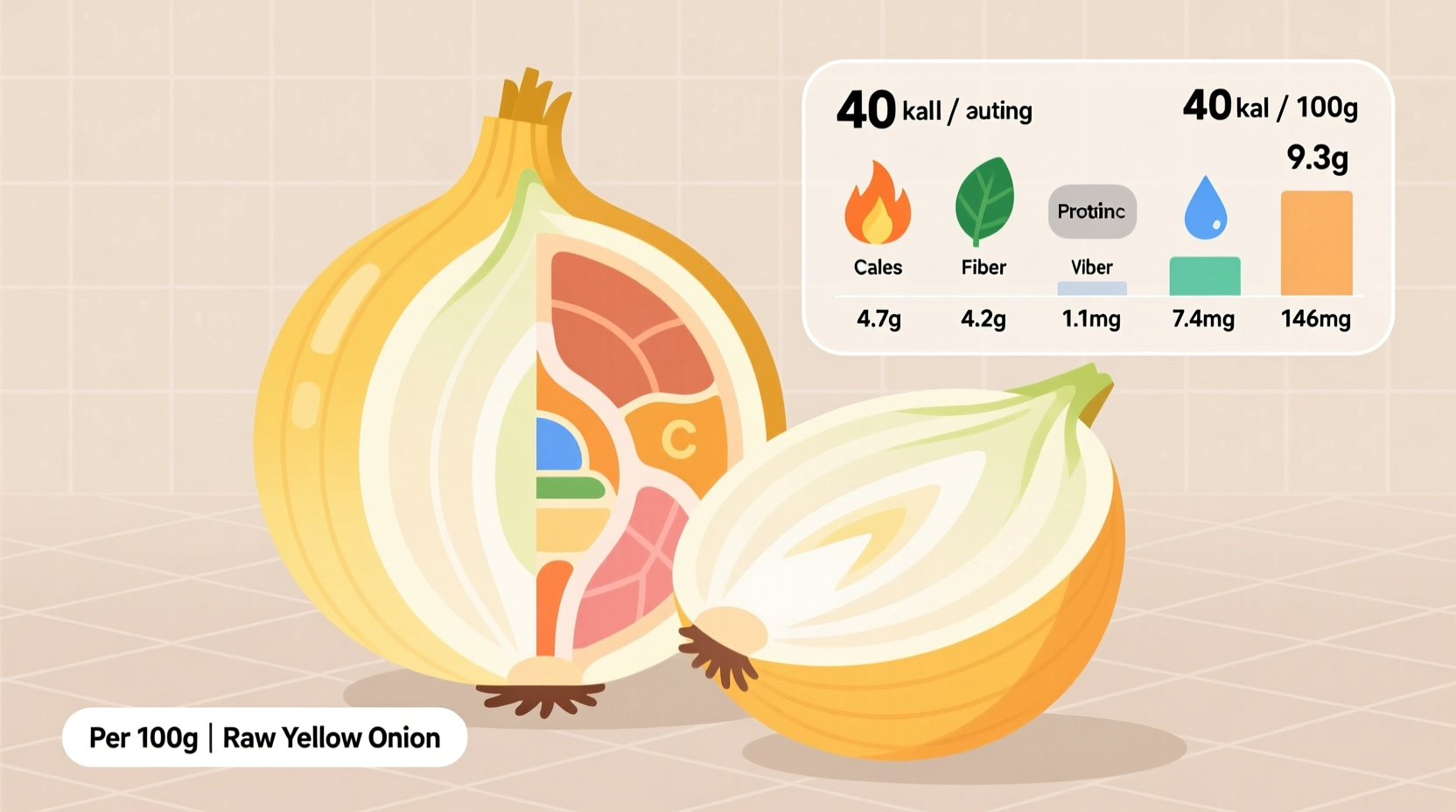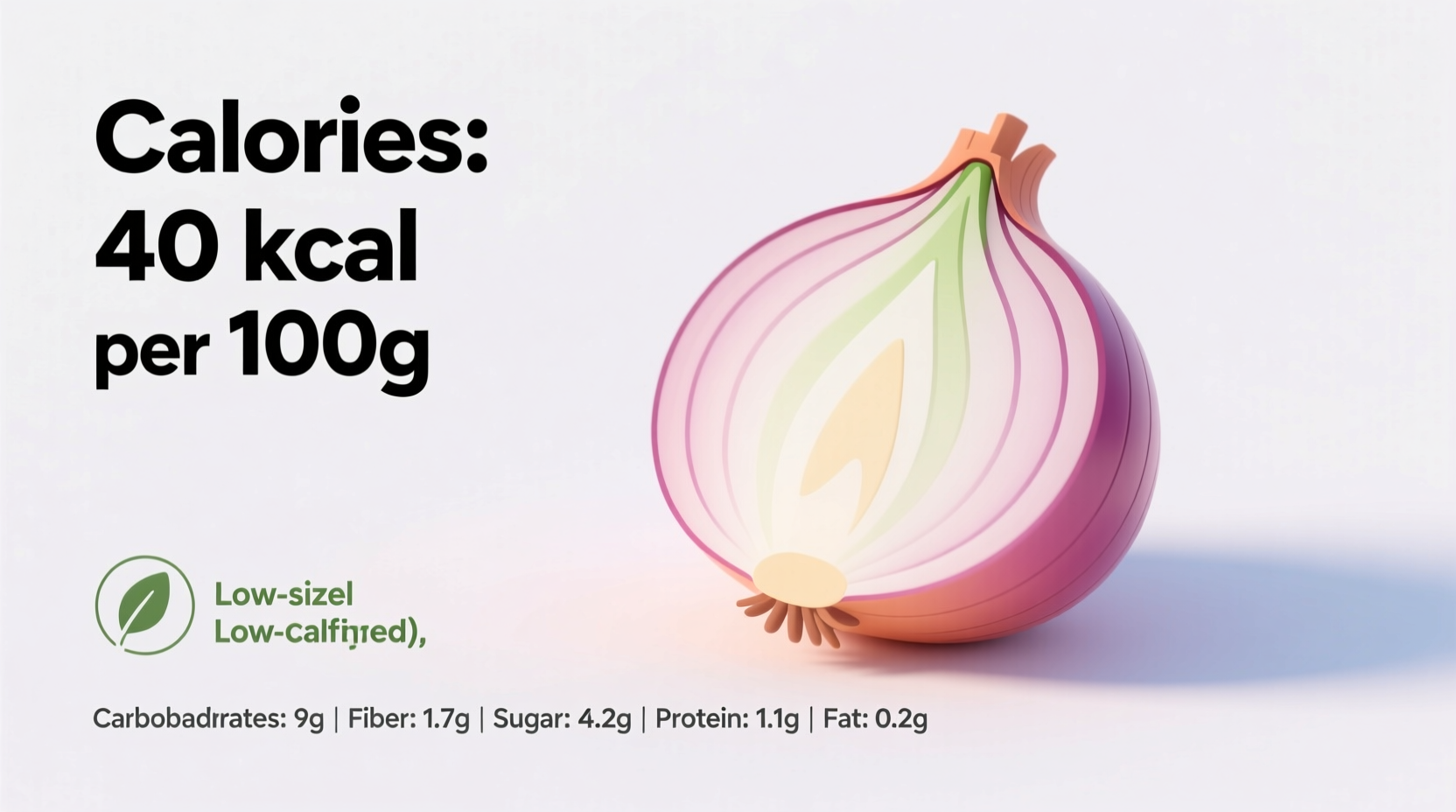Understanding the precise calorie content of onions helps home cooks and nutrition-conscious individuals make informed decisions in the kitchen. Whether you're following a specific diet plan or simply tracking your daily intake, knowing exactly what you're consuming matters.
Exact Calorie Counts by Onion Type
Not all onions are created equal when it comes to nutritional content. The calorie count varies slightly between varieties due to differences in water content and natural sugar levels. Here's a detailed breakdown based on USDA FoodData Central measurements:
| Onion Type | Per 100g | Medium Onion (110g) | 1 Cup, Chopped (160g) |
|---|---|---|---|
| Yellow Onion | 40 calories | 44 calories | 64 calories |
| Red Onion | 42 calories | 46 calories | 67 calories |
| White Onion | 43 calories | 47 calories | 69 calories |
| Green Onions (Scallions) | 32 calories | 16 calories (per 50g) | 32 calories |
This factual data comes directly from the USDA FoodData Central database, the most authoritative source for nutritional information in the United States. The slight variations between onion types primarily stem from differences in natural sugar content and moisture levels.

How Cooking Changes Onion Calorie Density
Many home cooks wonder whether cooking affects onion calorie content. The answer requires understanding how heat impacts vegetable composition:
Onions lose approximately 20-25% of their water content when cooked, which concentrates the remaining nutrients and calories. However, the total calorie count for the entire onion remains virtually unchanged. What changes is the calorie density per volume:
- Raw onion: 1 cup chopped = 64 calories
- Sautéed onion: 1 cup cooked = 85-90 calories (same total calories in a larger raw quantity)
- Caramelized onion: 1 cup = 120-140 calories (from approximately 2.5 cups raw)
This concentration effect explains why caramelized onions taste sweeter and have higher calorie density per cup, even though no additional calories have been introduced. The natural sugars become more concentrated as water evaporates during the slow cooking process.
Nutritional Context: Why Onion Calories Matter
Understanding onion calories within the broader nutritional picture reveals why they're such valuable kitchen staples:
Onions provide significant nutritional benefits beyond their minimal calorie count. A medium onion delivers:
- 12% of your daily vitamin C needs
- Valuable dietary fiber (1.9g per 100g)
- Antioxidants like quercetin
- Nearly zero fat content
- No cholesterol
Compared to other common vegetables, onions rank among the lowest in calories while providing substantial flavor. For perspective:
- Onion (100g): 40 calories
- Carrot (100g): 41 calories
- Celery (100g): 16 calories
- Broccoli (100g): 55 calories
- Tomato (100g): 18 calories
This makes onions particularly valuable for those following calorie-restricted diets who still want robust flavor in their meals without significant caloric impact.
Practical Kitchen Applications
Knowing the exact calorie content of onions allows for smarter cooking decisions:
Maximizing Flavor With Minimal Calories
Onions provide substantial flavor with minimal caloric investment. A single medium onion can flavor an entire pot of soup, stew, or sauce while contributing less than 50 calories to the entire dish. This makes them ideal for:
- Creating flavorful bases for sauces without added fats
- Adding bulk and texture to dishes while keeping calories low
- Enhancing meat dishes with minimal additional calories
Diet-Friendly Cooking Techniques
For those tracking calories precisely:
- Use raw onions in salads and salsas for maximum volume with minimal calories
- When sautéing, use minimal oil (1 tsp) to prevent excessive calorie addition
- For caramelizing, extend cooking time with a splash of water instead of additional oil
- Measure chopped onions rather than estimating when following strict calorie counts
Common Misconceptions About Onion Calories
Several myths persist about onion nutrition that deserve clarification:
- Myth: Cooking onions significantly increases their calorie count
Fact: The total calories remain the same; only the density per volume changes as water evaporates - Myth: Sweeter onion varieties have substantially more calories
Fact: While Vidalia and Walla Walla onions have slightly higher sugar content, the difference is minimal (about 2-3 extra calories per 100g) - Myth: Onion calories come primarily from carbohydrates
Fact: Onions are 89% water, with carbohydrates making up most of the remaining content (9.3g per 100g), primarily as natural sugars and fiber
These clarifications help ensure accurate nutritional tracking and informed cooking decisions.
Using Onions in Popular Diet Plans
Onions fit well within most dietary approaches due to their low calorie density and high flavor impact:
- Mediterranean Diet: Onions form the flavor base for countless Mediterranean dishes while contributing minimal calories
- Keto Diet: While higher in carbs than some vegetables, onions can be used in moderation (¼ cup portions)
- Weight Loss Diets: Onions add volume and flavor to meals without significant caloric cost
- Diabetes Management: The fiber content helps moderate blood sugar response to meals
For those following strict carbohydrate-restricted diets, green onions provide similar flavor with about 25% fewer calories and carbohydrates than bulb onions.











 浙公网安备
33010002000092号
浙公网安备
33010002000092号 浙B2-20120091-4
浙B2-20120091-4